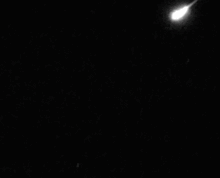

| Geminids (GEM) | |
|---|---|

The Geminids meteor shower as seen from the Northern Hemisphere, in December 2013
| |
| Pronunciation | /ˈdʒɛmənədz/ |
| Discovery date | 1862[1] |
| Parent body | 3200 Phaethon[2] |
| Radiant | |
| Constellation | Gemini (near Castor) |
| Right ascension | 07h28m [2] |
| Declination | +32°[2] |
| Properties | |
| Occurs during | 4 December – 17 December[2] |
| Date of peak | 14 December[2] |
| Velocity | 35[3] km/s |
| Zenithal hourly rate | 120[2] |
| See also: List of meteor showers | |
The Geminids are a prolific meteor shower caused by the object 3200 Phaethon,[4] which is thought to be an Apollo asteroid[5] with a "rock comet" orbit.[6] This would make the Geminids, together with the Quadrantids, the only major meteor showers not originating from a comet. The meteors from this shower are slow moving, can be seen in December and usually peak around December 4–16, with the date of highest intensity being the morning of December 14. Recent showers have seen 120–160 meteors per hour under optimal conditions, generally around 02:00 to 03:00 local time. Geminids were first observed in 1862,[1] much more recently than other showers such as the Perseids (36 AD) and Leonids (902 AD).
Based on data from the Parker Solar Probe, a 2023 study proposed that the Geminids may have been formed by the catastrophic breakup of a comet that formed asteroids 2005 UD and 1999 YC in addition to Phaethon.[7][8]
The Geminid meteor shower is unique among celestial events as it originates not from a comet but from the asteroid 3200 Phaethon, discovered on Oct. 11, 1983, by the Infrared Astronomical Satellite. Phaethon's 1.4-year orbit around the Sun and its comet-like elliptical trajectory have led scientists to speculate if it is a "dead comet" or a distinct celestial entity known as a "rock comet." Despite its comet-like orbit, Phaethon lacks a cometary tail and exhibits spectra resembling a rocky asteroid. The Geminid meteoroids formed from Phaethon are denser (2–3 g/cm3) than typical cometary dust flakes (0.3 g/cm3). Named after the Greek mythological figure who drove the Sun-god Helios' chariot, Phaethon's discovery was attributed to astronomer Fred Whipple.[9]


The meteors in this shower appear to come from the radiant in the constellation Gemini (hence the shower's name). However, they can appear almost anywhere in the night sky, and often appear yellowish in hue. Well north of the equator, the radiant rises about sunset, reaching a usable elevation from the local evening hours onwards. In the southern hemisphere, the radiant appears only around local midnight or so. Observers in the northern hemisphere will see higher Geminid rates as the radiant is higher in the sky.[10] The meteors travel at medium speed in relation to other showers, at about 22 miles per second (35 km/s), making them fairly easy to spot. The Geminids are now considered by many to be the most consistent and active annual shower. Geminids disintegrate while at heights above 24 miles (39 km).[11]

| Year | Peak of shower | ZHRmax | Lunar phase[12] |
|---|---|---|---|
| 2006 | December 14 | 115[13] | 33% waning crescent |
| 2007 | December 15 | 122[14] | 30% waxing crescent |
| 2008 | December 14 | 139[15] | 95% full moon |
| 2009 | December 13 | 120[16] | 9% new moon |
| 2010 | December 14 | 127[17] | 59% first quarter |
| 2011 | December 14 | 198[18] | 86% waning gibbous |
| 2012 | December 14[3] | 109[19] | 2% new moon |
| 2013 | December 14[20] | 134[21] | 92% full moon |
| 2014 | December 14[22] | 253[23] | 50% last quarter |
| 2015 | December 14 | 120[24] | 10% waxing crescent |
| 2016 | December 13 | 25[25] | 100% full moon |
| 2017 | December 14 | 145[26] | 13% waning crescent |
| 2018 | December 14 | 125±9[27] | 41% waxing crescent |
| 2019 | December 14 | 120[28] | 94% waning gibbous |
| 2020 | December 13 | 120[29] | 2% waning crescent |
| 2021 | December 13 | 125±25[30] | 73% waxing gibbous |
| 2022 | December 14 | 120 | 72% waning gibbous |
| 2023 | December 13 | 150[31] | 0% waxing crescent |
|
| |
|---|---|
| By name |
|
| By peak date |
|
| Related topics |
|
| |